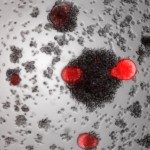Lien vers Pubmed [PMID] – 25658737
Med Sci (Paris) 2015 Jan;31(1):98-104
RNA viruses are responsible for major human diseases such as flu, bronchitis, dengue, hepatitis C or measles. They also represent an emerging threat because of increased worldwide exchanges and human populations penetrating more and more natural ecosystems. Recent progresses in our understanding of cellular pathways controlling viral replication suggest that compounds targeting host cell functions, rather than the virus itself, could inhibit a large panel of RNA viruses. In particular, several academic laboratories and private companies are now seeking molecules that stimulate the host innate antiviral response. One appealing strategy is to identify molecules that induce the large cluster of antiviral genes known as Interferon-Stimulated Genes (ISGs). To reach this goal, we have developed a phenotypic assay based on human cells transfected with a luciferase reporter gene under control of an interferon-stimulated response element (ISRE). This system was used in a high-throughput screening of chemical libraries comprising around 54,000 compounds. Among validated hits, compound DD264 was shown to boost the innate immune response in cell cultures, and displayed a broad-spectrum antiviral activity. While deciphering its mode of action, DD264 was found to target the fourth enzyme of de novo pyrimidine biosynthesis, namely the dihydroorotate dehydrogenase (DHODH). Thus, our data unraveled a yet unsuspected link between pyrimidine biosynthesis and the innate antiviral response.


